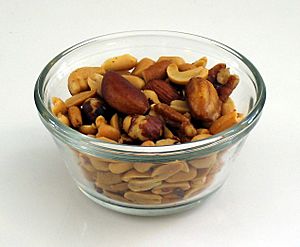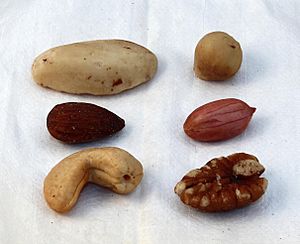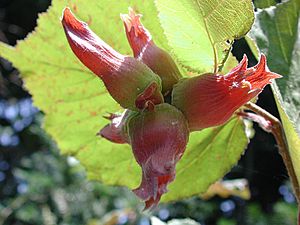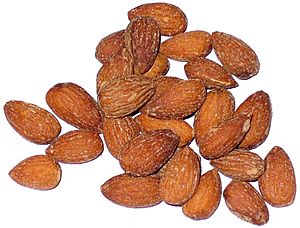List of culinary nuts facts for kids
A culinary nut is a dry, edible fruit or seed that people often eat. These nuts usually have a lot of fat, but not always. We use nuts in many ways, like in baking, as snacks (roasted or raw), and to add flavor to food. Besides nuts that are "true" nuts in a scientific way, other fruits and seeds that look and act like nuts in cooking are also called culinary nuts.
Culinary nuts can be grouped into four main types:
- True Nuts: These are dry fruits with a hard shell that don't open up when they are ripe. An example is the hazelnut.
- Drupes: These are seeds found inside a hard pit, which is surrounded by a soft, fleshy fruit. Think of almonds or walnuts.
- Gymnosperm Seeds: These are "naked" seeds, meaning they don't have a covering. Pine nuts are an example.
- Angiosperm Seeds: These seeds are inside a covering, like a pod or a fruit. A good example is the peanut.
Nuts have been an important food for a very long time. For many indigenous peoples of the Americas, nuts like acorns and American beech were a main source of starch and fat for thousands of years. Similarly, Indigenous Australians have eaten many kinds of nuts for centuries. Other culinary nuts, known since ancient times, are much more popular now. The peanut is a great example. Its use became very popular thanks to George Washington Carver. He found and shared many ways to use peanuts after planting them to help improve soil where cotton was grown.
Contents
What Are True Nuts?
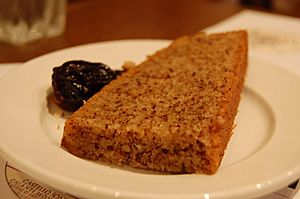
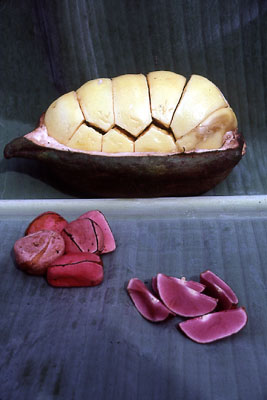
These nuts are considered "true" nuts both in cooking and by scientists.
- Acorn (from Quercus trees): Ancient indigenous peoples of the Americas used acorns as a main food, especially for making bread and porridge.
- Beech Nuts (from Fagus trees):
* American Beech (Fagus grandifolia): Indigenous peoples of the Americas ate these. Some tribes even looked for beech nuts collected by chipmunks and deer mice to get nuts that were already sorted and shelled! * European Beech (Fagus sylvatica): While you can eat them, they were not very popular for people. They were mostly used to feed animals or to make cooking oil.
- Breadnut (Brosimum alicastrum): The ancient Maya peoples used these to feed animals and as a backup food when other crops didn't grow well.
- Candlenut (Aleurites moluccana): This nut is used in many South East Asian dishes.
- Chestnuts (from Castanea trees):
* Chinese Chestnuts (Castanea mollissima): People in China have eaten these since ancient times. * Sweet Chestnuts (Castanea sativa): Unlike most nuts, these are high in starch and sugar. They are grown a lot in Europe and the Himalayas. * (Note: A water chestnut is not a nut; it's a tuber that grows in water.)
- Guinea Peanut (Pachira glabra): These seeds taste like peanuts. People usually boil or roast them. Roasted seeds are sometimes ground to make a hot drink.
- Hazelnuts (from Corylus trees): Most hazelnuts we eat come from the European hazelnut. Hazelnuts are used to make pralines, in the popular Nutella spread, in special drinks called liqueurs, and in many other foods.
* American Hazelnut (Corylus americana): This type is good for growing because it's quite tough. * European Hazelnut (Corylus avellana): This is where most of the hazelnuts you see in stores come from.
- Johnstone River Almond (Elaeocarpus bancroftii): This is a prized food among northern Indigenous Australians.
- Karuka (from Pandanus trees): These nuts are from Papua New Guinea. Both wild and planted types are eaten raw, roasted, or boiled. They help people have enough food when other foods are scarce.
- Kola Nut (from Cola trees): This nut comes from a tree in West Africa that is related to the cocoa tree. It's where the "cola" flavor in soft drinks first came from.
- Kurrajong (from Brachychiton trees): Native to Australia, these nuts are highly valued as a bush food by northern Indigenous Australians.
- Malabar Chestnut (Pachira aquatica): When raw, these taste like peanuts. When roasted, they taste like cashews or European chestnuts.
- Mongongo (Ricinodendron rautanenii): This nut is a great source of protein for the Bushmen in the Kalahari desert. It's also used to make oil for skin care.
- Sacha Inchi (Plukenetia volubilis): The roasted seeds of this plant can be eaten like nuts.
- Palm Nuts (Elaeis guineensis): These are an important food during times of hunger for the Himba people in Africa.
- Red Bopple Nut (Hicksbeachia pinnatifolia): Found on the east coast of Australia. It's low in fat and high in calcium and potassium. It's eaten as bush food.
- Yellow Walnut (Beilschmiedia bancroftii): Native to Australia, this nut was a main food for Indigenous Australians.
Nuts from Fleshy Fruits (Drupes)
A drupe is a fleshy fruit that has a hard stone or pit inside, and that pit holds a seed. Some of these seeds are also culinary nuts.
- Almonds (Prunus dulcis): Almonds have a long and important history in many cultures and religions as a food. They likely first grew in Central Asia and then spread across the Middle East and Eurasia in ancient times. The almond is one of only two nuts mentioned in the Bible.
- Apricot Kernels: Sometimes, the seeds from apricots are used instead of almonds, especially in a German sweet called "Persipan," which is used in foods like Stollen.
- Australian Cashew Nut (Semecarpus australiensis): This nut is a food source for Indigenous Australians in parts of Queensland and the Northern Territory.
- Baru Nut (Dipteryx alata): This nut is a food source for Afro-Brazilian communities in Brazil. People eat it toasted or boiled.
- Betel Nut (Areca catechu): Used in Indian cooking to make sweet treats after dinner and breath-fresheners.
- Borneo Tallow Nuts (from Shorea trees): These nuts grow in the tropical rain forests of South East Asia and are used to make edible oil.
- Canarium Nuts (from Canarium trees):
* Canarium Nut (Canarium harveyi, Canarium indicum, or Canarium commune): This has been an important food in Melanesia for a long time. * Pili Nuts (Canarium ovatum): These nuts are from the Philippines, where people have grown them for food since ancient times.
- Cashews (Anacardium occidentale): Cashews grow as a drupe attached to the cashew apple, which is the fruit of the cashew tree. They are from northeastern Brazil and were brought to India and East Africa in the 1500s. They are still a very important crop there. The nut must be roasted or steamed to remove a strong oil from its shell before you can eat it.
- Chilean Hazel (Gevuina avellana): This nut comes from an evergreen tree in South America. It looks and tastes similar to the hazelnut.
- Coconut (Cocos nucifera): Coconuts are used worldwide as food. The fleshy part of the seed is edible and used fresh or dried in many foods. The oil pressed from coconuts is also used in cooking.
- Gabon Nut (Coula edulis): This nut tastes like hazelnut or chestnut. It can be eaten raw, grilled, or boiled.
- Hickory Nuts (from Carya trees):
* Mockernut Hickory (Carya tomentosa): Native to North America, it's named because you need a heavy hammer to crack its hard shell! * Pecans (Carya illinoinensis): Pecans are the only major commercial nut tree that originally came from North America. People eat pecans as a snack and use them in baking. * Shagbark Hickory (Carya ovata): These nuts are a valuable food source for wildlife and were eaten by indigenous peoples and early settlers.
- Bush Mango (Irvingia gabonensis): This tree from Africa has both edible fruit and an edible nut. The nut is used to thicken stews and soups in West African cooking.
- Jack Nuts (Artocarpus heterophyllus): These are the seeds of the jackfruit. They taste like chestnuts and have very little fat (less than 1%).
- Jelly Palm Nut (Butia capitata): This palm has a sweet edible fruit and an edible nut.
- Bread Nuts (Artocarpus camansi): Similar to jack nuts, these also have a chestnut taste and very low fat content.
- Panda (Panda oleosa): Used in Gabon like bush mango nuts, and also to make edible oil.
- Pekea Nut (Caryocar nuciferum): Also called the butter-nut of Guiana, it's harvested locally for its highly valued edible oil.
- Pistachio (Pistacia vera L.): Pistachios have been grown for thousands of years and are from West Asia. It is one of only two nuts mentioned in the Bible.
- Walnuts (from Juglans trees):
* Black Walnut (Juglans nigra): Popular food for wildlife, with a unique flavor. It's from North America. * Butternut (Juglans cinerea): Also called white walnut, it's from North America. Native American tribes used it a lot as food in the past. * English Walnut (Juglans regia): Also called Persian walnut, it was brought to California around 1770. California now grows most of the walnuts in the US. It's often added to salads, vegetables, fruits, or desserts because of its special taste. * Heartnut (Juglans aitlanthifolia): From Japan, this nut has a special heart shape. Heartnuts are often toasted or baked and can be used instead of English walnuts.
Naked Seeds (Gymnosperms)
A gymnosperm comes from the Greek words meaning "naked seed." This means the seed does not have a covering. The following gymnosperms are culinary nuts. All of them, except the ginkgo nut, come from evergreen trees.
- Cycads (from Macrozamia trees):
* Burrawang Nut (Macrozamia communis): This was a major source of starch for Indigenous Australians around Sydney.
- Ginkgo Nuts (Ginkgo biloba): These are a common ingredient in Chinese cooking. They are starchy, low in fat, protein, and calories, but high in vitamin C.
- Araucaria Nuts (from Araucaria trees):
* Bunya Nut (Araucaria bidwillii): This nut is from Queensland, Australia. Bunya nuts are about the size of walnuts and have a lot of starch. * Monkey-Puzzle Nut (Araucaria araucana): These nuts are twice the size of almonds and are rich in starch. They are roasted, boiled, eaten raw, or fermented in Chile and Argentina. * Paraná Pine Nut (Araucaria angustifolia): Also called Brazil pine nut, it's an edible seed similar to pine nuts.
- Pine Nuts (from Pinus trees): Pine nuts can be toasted and added to salads. They are also used as an ingredient in pesto, among other regional dishes.
* Chilgoza Pine (Pinus gerardiana): Common in Central Asia. The nuts are eaten raw, roasted, or in sweet treats. * Colorado Pinyon (Pinus edulis): This nut is in high demand, with thousands of pounds produced each year. * Korean Pine (Pinus koraiensis): A type of pine tree from Asia that gives us pine nuts. * Mexican Pinyon (Pinus cembroides): Found in Mexico and Arizona. The nuts are eaten raw, roasted, or made into flour. * Stone Pine (Pinus pinea): Also called pignolia nut, this is the most important pine nut for business.
Seeds from Flowering Plants (Angiosperms)
These culinary nuts are seeds found inside a larger fruit, and they come from flowering plants.
- Brazil Nut (Bertholletia excelsa): These nuts are harvested from many trees each year. They are highly valued and used in sweets and baking. They are also an excellent source of selenium.
- Macadamia (from Macadamia trees): Macadamias are mainly grown in Hawaii and Australia. Both types are originally from Australia. They are very valuable nuts. Nuts that can't be sold are often used to make edible oil.
* Queensland Macadamia Nut (Macadamia integrifolia): This type has a smooth shell and is the main macadamia nut sold.
- Paradise Nut (Lecythis usitata): From the Amazon rain forest, this nut is highly valued by local tribal people.
- Peanut (Arachis hypogaea): Also called groundnut, the peanut is a legume that grows underground, not on a tree or bush. It originally came from South America. It has grown from a small crop to one of the most important commercial nut crops, partly thanks to the work of George Washington Carver in the early 1900s.
- Peanut Tree (Sterculia quadrifida): Also called bush peanut, this tree is from Australia. Its nuts don't need any special preparation.
- Soybean (Glycine max): A legume that grows underground, soybeans are used as a nut, but mostly for their oil seed.
See also
 In Spanish: Anexo:Nueces con valor culinario para niños
In Spanish: Anexo:Nueces con valor culinario para niños
- List of edible seeds
- Tiger nut (not a nut, despite its name)


